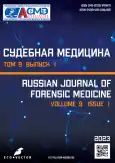糖尿病昏迷在糖尿病病人的死亡率结构
- 作者: Akimov P.A.1,2, Barinov E.K.3, Terekhina N.A.1
-
隶属关系:
- E.A. Vagner Perm State Medical University
- Perm Regional Bureau of Forensic Medical Examination
- Moscow State University of Medicine and Dentistry named after A.I. Evdokimov
- 期: 卷 9, 编号 1 (2023)
- 页面: 41-48
- 栏目: 原创研究
- URL: https://bakhtiniada.ru/2411-8729/article/view/133083
- DOI: https://doi.org/10.17816/fm410
- ID: 133083
如何引用文章
全文:
详细
论证。由于国内大多数地区在尸检阶段中的诊断不足,关于糖尿病病人的死亡原因信息不符合现实。
研究目的是在2017-2020年内由于糖尿病昏迷导致的糖尿病患者死亡率的统计分析。
材料与方法。进行了血液检测和玻璃体的生物化学分析。测定血液中的糖化血红蛋白以确认是否存在糖尿病。测定玻璃体中的葡萄糖、乳酸盐和丁铜酸酯的含量。我们之前已制定了通过玻璃体的生化分析对糖尿病昏迷进行鉴别诊断的标准。
结果。这项研究是在4444名猝然去世的糖尿病患者的尸体上进行的(这些患者在生前被登记为糖尿病病人)所有糖尿病患者的糖化血红蛋白水平都提高了。在分析糖尿病患者的死亡率结构时,发现了692个人的死因是糖尿病昏迷,占15.6%。在糖尿病患者的死亡率结构中,糖尿病昏迷的比例比统计数据中注明的的要高得多。这种情况是由于在死后诊断阶段中采用的实验室检查不足,以及糖尿病患者由于糖尿病昏迷导致的死因编码有限。制定的糖尿病昏迷诊断方式是易于执行的,确保结果的很高的准确性和可靠性,任何专业实验室都可以进行。
结论。最常见的是昏迷前状态(高渗性非酮症酸中毒昏迷的发作),其与昏迷结合在一起,使糖尿病昏迷的死亡率百分比最高。近年来,糖尿病昏迷导致的死亡率有下降的趋势。
作者简介
Pavel A. Akimov
E.A. Vagner Perm State Medical University; Perm Regional Bureau of Forensic Medical Examination
Email: p.a.akimov@yandex.ru
ORCID iD: 0000-0003-4347-8760
SPIN 代码: 9597-4566
Scopus 作者 ID: 56426895500
MD, Cand. Sci. (Med.), Associate Professor
俄罗斯联邦, Perm; PermEvgeny K. Barinov
Moscow State University of Medicine and Dentistry named after A.I. Evdokimov
Email: ev.barinov@mail.ru
ORCID iD: 0000-0003-4236-4219
SPIN 代码: 2112-4568
MD, Dr. Sci. (Med.), Professor
俄罗斯联邦, MoscowNatalya A. Terekhina
E.A. Vagner Perm State Medical University
编辑信件的主要联系方式.
Email: terekhina@list.ru
ORCID iD: 0000-0002-0168-3785
SPIN 代码: 7663-4110
Scopus 作者 ID: 7004162006
MD, Dr. Sci. (Med.), Professor
俄罗斯联邦, Perm参考
- Dedov II, ShestakovaMV, Vikulova OK, et al. Diabetes mellitus in Russian Federation: prevalence, morbidity, mortality, parameters of glycaemic control and structure of hypoglycaemic therapy according to the Federal Diabetes Register, status 2017. Diabetes Mellitus. 2018;21(3):144–159. (In Russ). doi: 10.14341/DM9686
- Dezhinova TA, Popov VL, Zaslavskii GI. Forensic biochemical research. Saint Petersburg; 2003. 96 р. (In Russ).
- Avhodiev GI, Kuzmina OV, Rafibekov MG. Proteins and their derivatives in the post-mortem period. Chita: Poisk; 2002. 79 р. (In Russ).
- Terekhina NA, Akimov PA. Biochemical analysis of the vitreous body of the eye in post-mortem diagnosis of diabetic coma. Pathological Physiology Experimental Therapy. 2005;(2):24–25. (In Russ).
- Patent RUS № 2131700 С1/20.06.1999. Akimov PA, Terekhina NA. Method of diagnosis of hyperglycemic coma in the postmortem periode. (In Russ). Available from: https://yandex.ru/patents/doc/RU2131700C1_19990620. Accessed: 12.05.2022.
- Akimov PA, Terekhina NA. Biochemical indices of vitreous humor in diagnosis of diseases. Perm Med J. 2016;33(4):61–64. (In Russ).
- Hess C, Musshoff F, Madea B. Disorders of glucose metabolism -- post mortem analyses in forensic cases: Part I. In J Legal Med. 2011;125(2):163–170. doi: 10.1007/s00414-010-0509-6
- Musshoff F, Hess C, Madea B. Disorders of glucose metabolism: Post mortem analyses in forensic cases – part II. Int J Legal Med. 2011;125(2):171–180. doi: 10.1007/s00414-010-0510-0
- Heimer J, Gascho D, Madea B, et al. Comparison of the beta-hydroxybutyrate, glucose and lactate concentrations derived from postmortem proton magnetic resonance spectroscopy and biochemical analysis for the diagnosis of fatal metabolic disorders. Int J Legal Med. 2020;134(2):603–612. doi: 10.1007/s00414-019-02235-6
- Kachina NN. Postmortal evaluation of glucose and glycosylated blood Hb levels. Forensic Med\ Examination. 1991;34(4):7–10. (In Russ).
- Hindle EJ, Rostron GM, Gatt JA. The diagnostic value of glycated haemoglobin levels in postmortem blood. Ann Clin Biochem. 1985;22(Pt2):144–147. doi: 10.1177/000456328502200206
- Nikolaev BS, Kinle AE, Samarkina OYu. On the possibility of postmortem diagnosis of diabetes mellitus. Forensic Med Examenation. 2010;53(5):39–40. (In Russ).
- Akimov PA, Terekhina NA, Viter VI, Barinov EK. Postmortem diagnosis of hypoglycemic coma by biochemical analysis of the vitreous body. Modern Problems Sci Education. 2019;(2):99. (In Russ).
补充文件








